unit 5 课文精讲精练现在完成时讲与练
- 格式:doc
- 大小:51.50 KB
- 文档页数:7
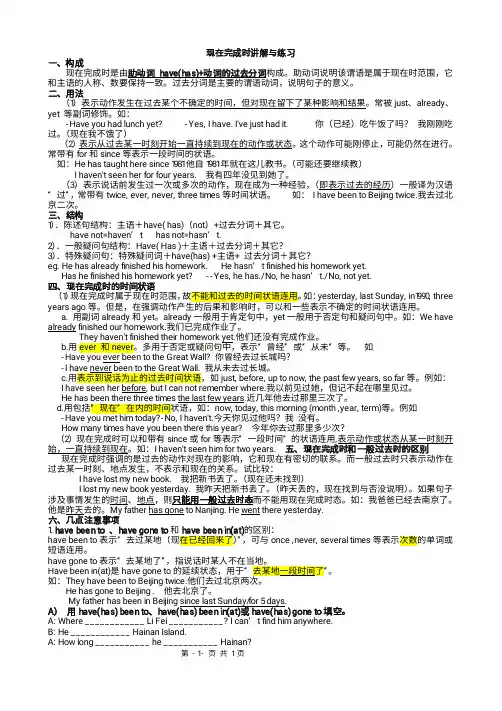
现在完成时讲解与练习一、构成现在完成时是由助动词h a v e(h a s)+动词的过去分词构成。
助动词说明该谓语是属于现在时范围,它和主语的人称、数要保持一致。
过去分词是主要的谓语动词,说明句子的意义。
二、用法(1)表示动作发生在过去某个不确定的时间,但对现在留下了某种影响和结果。
常被j u s t、a l r e a d y、y e t等副词修饰。
如:-H a v e y o u h a d l u n c h y e t?-Y e s,I h a v e.I'v e j u s t h a d i t.你(已经)吃午饭了吗?我刚刚吃过。
(现在我不饿了)(2)表示从过去某一时刻开始一直持续到现在的动作或状态。
这个动作可能刚停止,可能仍然在进行。
常带有f o r和s i n c e等表示一段时间的状语。
如:H e h a s t a u g h t h e r e s i n c e1981他自1981年就在这儿教书。
(可能还要继续教)I h a v e n't s e e n h e r f o r f o u r y e a r s.我有四年没见到她了。
(3)表示说话前发生过一次或多次的动作,现在成为一种经验,(即表示过去的经历)一般译为汉语“过”,常带有t w i c e,e v e r,n e v e r,t h r e e t i m e s等时间状语。
如:I h a v e b e e n t o B e i j i n g t w i c e.我去过北京二次。
三、结构1).陈述句结构:主语+h a v e(h a s)(n o t)+过去分词+其它。
h a v e n o t=h a v e n’t h a s n o t=h a s n’t.2).一般疑问句结构:H a v e(H a s)+主语+过去分词+其它?3).特殊疑问句:特殊疑问词+h a v e(h a s)+主语+过去分词+其它?e g.H e h a s a l r e a d yf i n i s h e d h i s h o m e w o r k.H e h a s n’t f i n i s h e d h i s h o m e w o r k y e t.H a s h e f i n i s h e d h i s h o m e w o r k y e t?--Y e s,h e h a s./N o,h e h a s n’t./N o,n o t y e t.四、现在完成时的时间状语(1)现在完成时属于现在时范围,故不能和过去的时间状语连用。
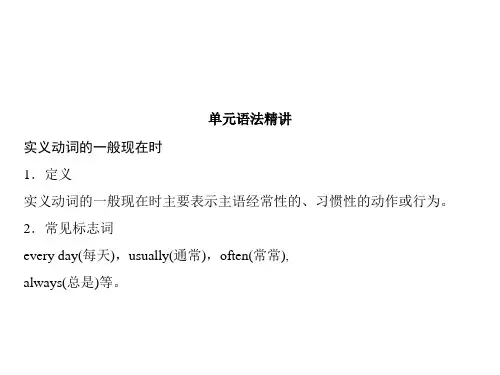
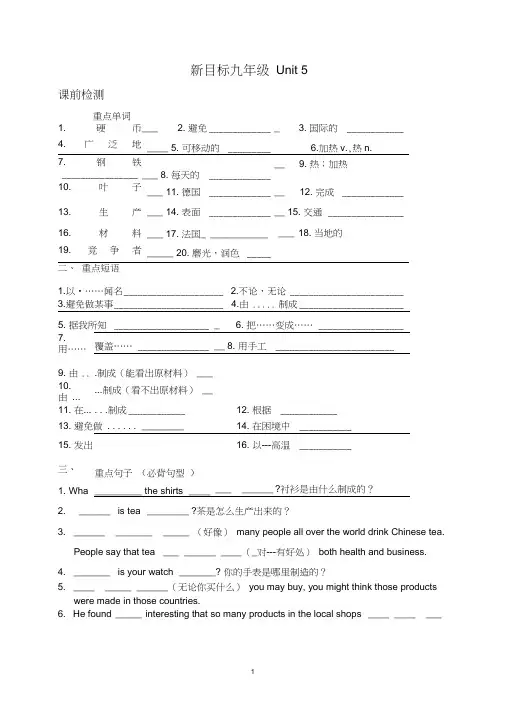
新目标九年级 Unit 5课前检测重点单词 1. 硬币 ________________ ___ 2. 避免 _____________ _ 3. 国际的 ____________4. 广泛地 ________________ ____5. 可移动的 _________6.加热v.,热n.7. 钢铁 ________________ ___8. 每天的 _____________ __9. 热;加热10. 叶子 ___________________ 11. 德国 _____________ __ 12. 完成 _____________ 13. 生产 ________________ ___ 14. 表面 _____________ __ 15. 交通 ________________16. 材料 ________________ ___ 17. 法国_ ___________ ___ 18. 当地的____ 19. 竞争者 ________________ _____ 20. 磨光,润色 _____二、 重点短语 1.以•……闻名 _____________________ 2.不论,无论 ________________________3.避免做某事 _______________________4.由 ..... 制成 ______________________5. 据我所知 ____________________ _6. 把……变成…… __________________7. 用…… 覆盖……_______________ __ 8. 用手工 _________________________ 9. 由 .. .制成(能看出原材料) ___10. 由 ......制成(看不出原材料) __ 11. 在... . . .制成 ____________12. 根据 ____________ 13. 避免做 . . . . . . ________14. 在困境中 ___________15. 发出16. 以---高温 ___________ 三、重点句子 (必背句型 )1. Wha _________ the shirts ____ ___ ______ ?衬衫是由什么制成的?2. ______ is tea ________ ?茶是怎么生产出来的?3. ______ _______ _____ (好像) many people all over the world drink Chinese tea. People say that tea ___ ______ ____ (_对---有好处) both health and business.4. _______ is your watch _______ ? 你的手表是哪里制造的?5. ____ _____ ______ (无论你买什么) you may buy, you might think those products were made in those countries.6. He found _____ interesting that so many products in the local shops ____ ____ ___China.他发现一件有趣的事,那就是当地的商店里如此多的产品都产自中国7. He realized that America ns can hardly avoid _____ products _____ in Chi na.他意识到美国人几乎不能够买到买到中国制造的产品。
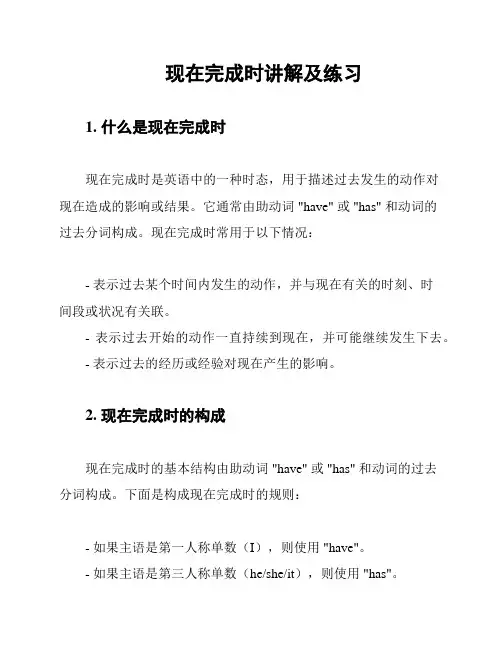
现在完成时讲解及练习1. 什么是现在完成时现在完成时是英语中的一种时态,用于描述过去发生的动作对现在造成的影响或结果。
它通常由助动词 "have" 或 "has" 和动词的过去分词构成。
现在完成时常用于以下情况:- 表示过去某个时间内发生的动作,并与现在有关的时刻、时间段或状况有关联。
- 表示过去开始的动作一直持续到现在,并可能继续发生下去。
- 表示过去的经历或经验对现在产生的影响。
2. 现在完成时的构成现在完成时的基本结构由助动词 "have" 或 "has" 和动词的过去分词构成。
下面是构成现在完成时的规则:- 如果主语是第一人称单数(I),则使用 "have"。
- 如果主语是第三人称单数(he/she/it),则使用 "has"。
- 其他所有人称(一般为复数形式)使用 "have"。
动词的过去分词形式主要有三种:- 以 "-ed" 结尾的动词,如 "worked"。
- 不规则动词过去分词,如 "gone"。
- 部分动词过去分词与原形一样,如 "put"。
3. 现在完成时的使用示例表示过去某个时间内的动作- I have traveled to many countries.(我去过很多国家。
)- She has read five books this month.(她这个月读了五本书。
)表示持续到现在的动作- They have lived in this city since 2005.(他们从2005年开始就一直住在这个城市。
)表示过去的经历对现在的影响- I have studied English for many years, so now I can speak it fluently.(我学了很多年英语,所以现在我能够流利地说它。
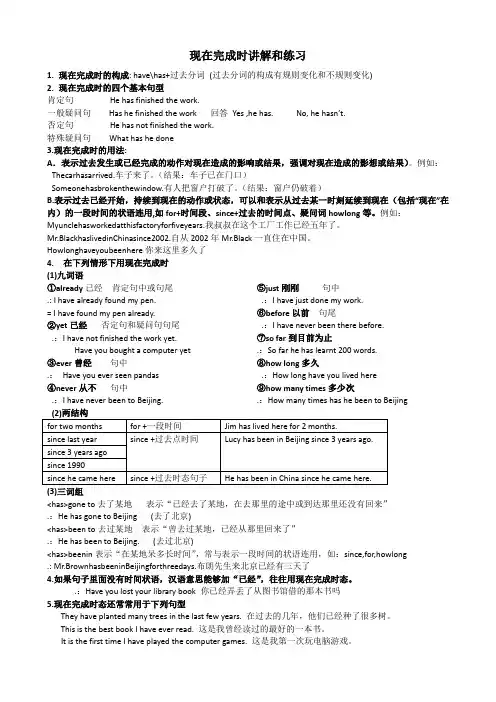
现在完成时讲解和练习1. 现在完成时的构成: have\has+过去分词(过去分词的构成有规则变化和不规则变化)2. 现在完成时的四个基本句型肯定句He has finished the work.一般疑问句Has he finished the work 回答Yes ,he has. No, he hasn’t.否定句He has not finished the work.特殊疑问句What has he done3.现在完成时的用法:A.表示过去发生或已经完成的动作对现在造成的影响或结果,强调对现在造成的影想或结果)。
例如:Thecarhasarrived.车子来了。
(结果:车子已在门口)Someonehasbrokenthewindow.有人把窗户打破了。
(结果:窗户仍破着)B.表示过去已经开始,持续到现在的动作或状态,可以和表示从过去某一时刻延续到现在(包括“现在”在内)的一段时间的状语连用,如for+时间段、since+过去的时间点、疑问词howlong等。
例如:Myunclehasworkedatthisfactoryforfiveyears.我叔叔在这个工厂工作已经五年了。
Mr.BlackhaslivedinChinasince2002.自从2002年Mr.Black一直住在中国。
Howlonghaveyoubeenhere你来这里多久了4. 在下列情形下用现在完成时(1)九词语①already已经肯定句中或句尾.: I have already found my pen.= I have found my pen already.②yet已经否定句和疑问句句尾.:I have not finished the work yet.Have you bought a computer yet ③ever曾经句中.:Have you ever seen pandas④never从不句中.:I have never been to Beijing.⑤just刚刚句中.:I have just done my work.⑥before以前句尾.:I have never been there before.⑦so far到目前为止.:So far he has learnt 200 words.⑧how long多久.:How long have you lived here⑨how many times多少次.:How many times has he been to Beijing(3)三词组<has>gone to去了某地表示“已经去了某地,在去那里的途中或到达那里还没有回来”.:He has gone to Beijing (去了北京)<has>been to去过某地表示“曾去过某地,已经从那里回来了”.:He has been to Beijing. (去过北京)<has>beenin表示“在某地呆多长时间”,常与表示一段时间的状语连用,如:since,for,howlong .: Mr.BrownhasbeeninBeijingforthreedays.布朗先生来北京已经有三天了4.如果句子里面没有时间状语,汉语意思能够加“已经”,往往用现在完成时态。
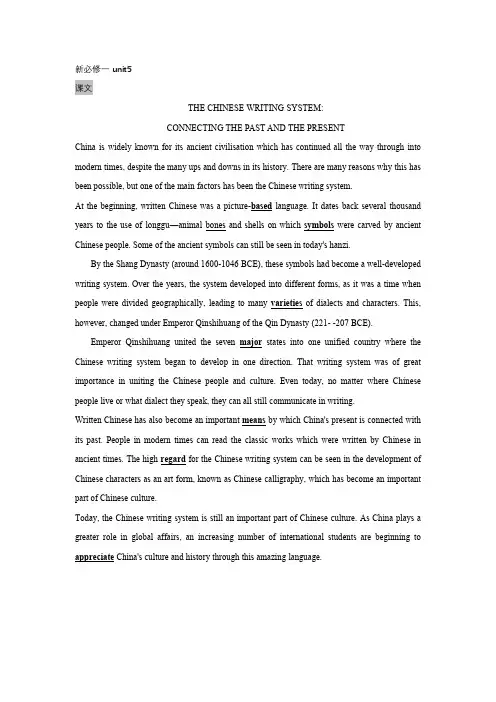
新必修一unit5课文THE CHINESE WRITING SYSTEM:CONNECTING THE PAST AND THE PRESENTChina is widely known for its ancient civilisation which has continued all the way through into modern times,despite the many ups and downs in its history.There are many reasons why this has been possible,but one of the main factors has been the Chinese writing system.At the beginning,written Chinese was a picture-based language.It dates back several thousand years to the use of longgu—animal bones and shells on which symbols were carved by ancient Chinese people.Some of the ancient symbols can still be seen in today's hanzi.By the Shang Dynasty(around1600-1046BCE),these symbols had become a well-developed writing system.Over the years,the system developed into different forms,as it was a time when people were divided geographically,leading to many varieties of dialects and characters.This, however,changed under Emperor Qinshihuang of the Qin Dynasty(221--207BCE).Emperor Qinshihuang united the seven major states into one unified country where the Chinese writing system began to develop in one direction.That writing system was of great importance in uniting the Chinese people and culture.Even today,no matter where Chinese people live or what dialect they speak,they can all still communicate in writing.Written Chinese has also become an important means by which China's present is connected with its past.People in modern times can read the classic works which were written by Chinese in ancient times.The high regard for the Chinese writing system can be seen in the development of Chinese characters as an art form,known as Chinese calligraphy,which has become an important part of Chinese culture.Today,the Chinese writing system is still an important part of Chinese culture.As China plays a greater role in global affairs,an increasing number of international students are beginning to appreciate China's culture and history through this amazing language.中文书写系统:连接过去和现在中国以其一直延续到现代的古老文明而闻名,尽管在它的历史上有许多起起落落。
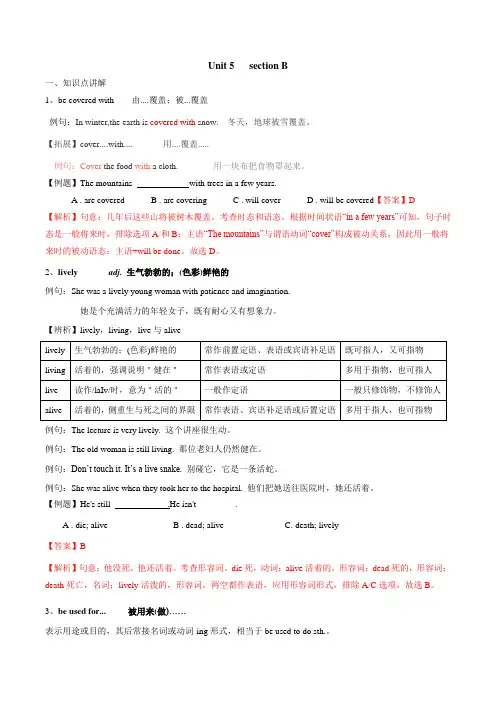
Unit 5 section B一、知识点讲解1、be covered with 由....覆盖;被...覆盖例句:In winter,the earth is covered with snow. 冬天,地球被雪覆盖。
【拓展】cover....with.... 用....覆盖.....例句:Cover the food with a cloth. 用一块布把食物罩起来。
【例题】The mountains with trees in a few years.A . are coveredB . are coveringC . will coverD . will be covered【答案】D【解析】句意:几年后这些山将被树木覆盖。
考查时态和语态。
根据时间状语“in a few years”可知,句子时态是一般将来时,排除选项A和B;主语“The mountains”与谓语动词“cover”构成被动关系,因此用一般将来时的被动语态:主语+will be done。
故选D。
2、lively adj.生气勃勃的;(色彩)鲜艳的例句:She was a lively young woman with patience and imagination.她是个充满活力的年轻女子,既有耐心又有想象力。
【辨析】lively,living,live与alive例句:The lecture is very lively. 这个讲座很生动。
例句:The old woman is still living. 那位老妇人仍然健在。
例句:Don’t touch it. It’s a live snake. 别碰它,它是一条活蛇。
例句:She was alive when they took her to the hospital. 他们把她送往医院时,她还活着。
【例题】He's still .He isn't_________.A . die; aliveB . dead; alive C. death; lively【答案】B【解析】句意:他没死。
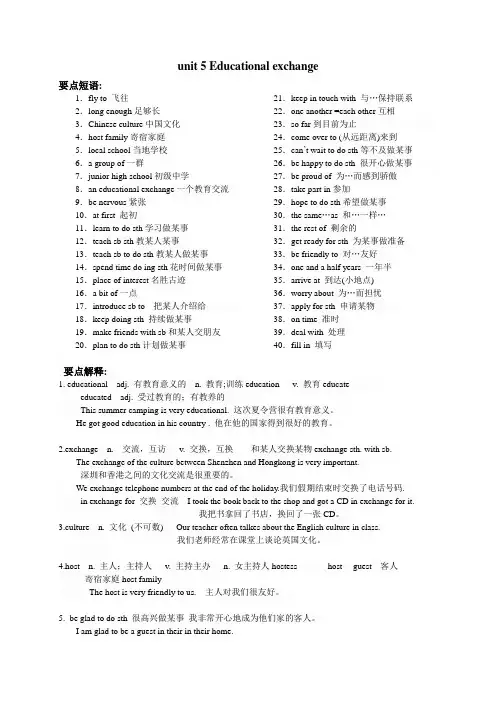
unit 5 Educational exchange 要点短语:1.fly to 飞往2.long enough足够长3.Chinese culture中国文化4.host family寄宿家庭5.local school当地学校6.a group of一群7.junior high school初级中学8.an educational exchange一个教育交流9.be nervous紧张10.at first 起初11.learn to do sth学习做某事12.teach sb sth教某人某事13.teach sb to do sth教某人做某事14.spend time do ing sth花时间做某事15.place of interest名胜古迹16.a bit of一点17.introduce sb to 把某人介绍给18.keep doing sth 持续做某事19.make friends with sb和某人交朋友20.plan to do sth计划做某事21.keep in touch with 与…保持联系22.one another =each other互相23.so far到目前为止24.come over to (从远距离)来到25.can’t wait to do sth等不及做某事26.be happy to do sth 很开心做某事27.be proud of 为…而感到骄傲28.take part in参加29.hope to do sth希望做某事30.the same…as 和…一样…31.the rest of 剩余的32.get ready for sth 为某事做准备33.be friendly to 对…友好34.one and a half years 一年半35.arrive at 到达(小地点) 36.worry about 为…而担忧37.apply for sth 申请某物38.on time 准时39.deal with 处理40.fill in 填写要点解释:1. educational adj. 有教育意义的n. 教育;训练education v. 教育educateeducated adj. 受过教育的;有教养的This summer camping is very educational. 这次夏令营很有教育意义。
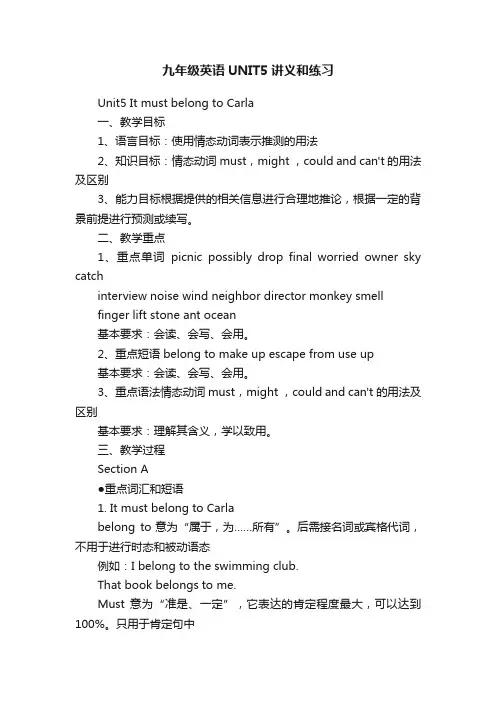
九年级英语UNIT5讲义和练习Unit5 It must belong to Carla一、教学目标1、语言目标:使用情态动词表示推测的用法2、知识目标:情态动词must,might ,could and can't 的用法及区别3、能力目标根据提供的相关信息进行合理地推论,根据一定的背景前提进行预测或续写。
二、教学重点1、重点单词picnic possibly drop final worried owner sky catchinterview noise wind neighbor director monkey smellfinger lift stone ant ocean基本要求:会读、会写、会用。
2、重点短语belong to make up escape from use up基本要求:会读、会写、会用。
3、重点语法情态动词must,might ,could and can't 的用法及区别基本要求:理解其含义,学以致用。
三、教学过程Section A●重点词汇和短语1. It must belong to Carlabelong to意为“属于,为……所有”。
后需接名词或宾格代词,不用于进行时态和被动语态例如:I belong to the swimming club.That book belongs to me.Must 意为“准是、一定”,它表达的肯定程度最大,可以达到100%。
只用于肯定句中2.He was the only little kid at the picniconly作形容词,意为“唯一的,仅有的”可用来修饰名词.例如:He is the only boy in his family.【拓展】only作副词,意为“只,仅,才”修饰主语时,only常置于主语之前例如:Only a doctor can do that.修饰主语以外的成分时,only常置于行为动词之前,be动词,情态动词,助动词后例如:I only touched it.要确定所修饰的事物时,则置于所修饰的词和短语之前.例如:I had only 20 pence.3.U se “might”or “could”to show that you think something is possibly true. Possibly作副词意为“可能地,也许”例如:.Possibly he was telling the truth.【拓展】possibly与can could连用以加强语气。
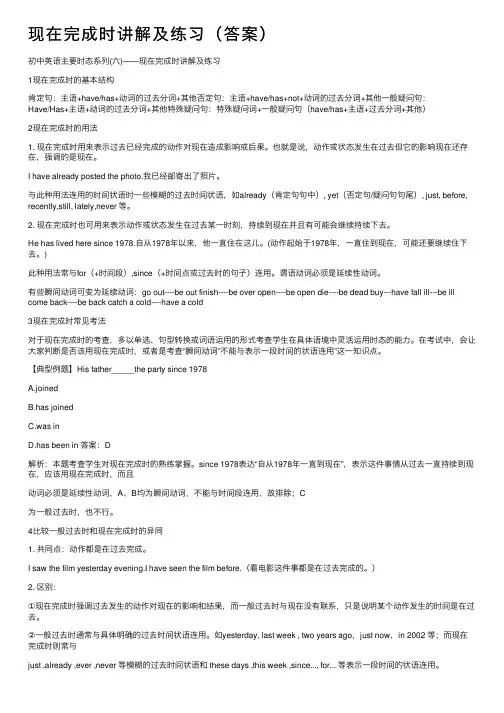
现在完成时讲解及练习(答案)初中英语主要时态系列(六)——现在完成时讲解及练习1现在完成时的基本结构肯定句:主语+have/has+动词的过去分词+其他否定句:主语+have/has+not+动词的过去分词+其他⼀般疑问句:Have/Has+主语+动词的过去分词+其他特殊疑问句:特殊疑问词+⼀般疑问句(have/has+主语+过去分词+其他)2现在完成时的⽤法1. 现在完成时⽤来表⽰过去已经完成的动作对现在造成影响或后果。
也就是说,动作或状态发⽣在过去但它的影响现在还存在,强调的是现在。
I have already posted the photo.我已经邮寄出了照⽚。
与此种⽤法连⽤的时间状语时⼀些模糊的过去时间状语,如already(肯定句句中), yet(否定句/疑问句句尾), just, before, recently,still, lately,never 等。
2. 现在完成时也可⽤来表⽰动作或状态发⽣在过去某⼀时刻,持续到现在并且有可能会继续持续下去。
He has lived here since 1978.⾃从1978年以来,他⼀直住在这⼉。
(动作起始于1978年,⼀直住到现在,可能还要继续住下去。
)此种⽤法常与for(+时间段),since(+时间点或过去时的句⼦)连⽤。
谓语动词必须是延续性动词。
有些瞬间动词可变为延续动词:go out----be out finish----be over open----be open die----be dead buy---have fall ill---be ill come back----be back catch a cold----have a cold3现在完成时常见考法对于现在完成时的考查,多以单选、句型转换或词语运⽤的形式考查学⽣在具体语境中灵活运⽤时态的能⼒。
在考试中,会让⼤家判断是否该⽤现在完成时,或者是考查“瞬间动词”不能与表⽰⼀段时间的状语连⽤”这⼀知识点。
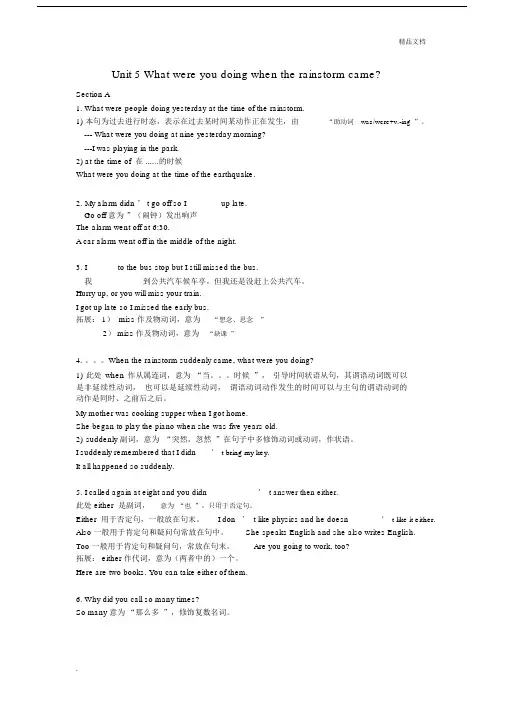
Unit 5 What were you doing when the rainstorm came?Section A1. What were people doing yesterday at the time of the rainstorm.1) 本句为过去进行时态,表示在过去某时间某动作正在发生,由“助动词was/were+v.-ing”。
--- What were you doing at nine yesterday morning?---I was playing in the park.2) at the time of 在 ......的时候What were you doing at the time of the earthquake.2.My alarm didn ’ t go off so I _______ up late.Go off 意为”(闹钟)发出响声The alarm went off at 6:30.A car alarm went off in the middle of the night.3. I ______ to the bus stop but I still missed the bus.我 __________ 到公共汽车候车亭,但我还是没赶上公共汽车。
Hurry up, or you will miss your train.I got up late so I missed the early bus.拓展: 1) miss 作及物动词,意为“想念、思念”2) miss 作及物动词,意为“缺课”4. 。
When the rainstorm suddenly came, what were you doing?1)此处when 作从属连词,意为“当。
时候”,引导时间状语从句,其谓语动词既可以是非延续性动词,也可以是延续性动词,谓语动词动作发生的时间可以与主句的谓语动词的动作是同时、之前后之后。
一般现在时被动语态学习三要素一、掌握一般现在时被动语态概念及构成一般现在时被动语态表示现阶段经常性、习惯性被动动作,由主语+is/am/are+及物动词过去分词+动作执行者构成,无需说明动作执行者时可省去by+动作执行者,句中主语就是原主动语态的宾语,动作执行者就是原主动语态的主语。
is/am/are由主语的单复数形式而定,主语为第三人称单数名词或代词时用is,主语为I时用am。
主语为复数名词或代词或时用。
I know this song is often sung by him.我知道他经常唱这首歌。
The fIowers in my garden are watered every day.我花园里的花每天都浇水。
Quite a few lessons are taught in our class.我班开设好几门课。
二、掌握一般现在时被动语态句型变换方法一般现在时被动语态句型变换紧紧扣住助动词is/am/are进行,一般疑问句将is/am/are提至句首,特殊疑问句由特殊疑问词+一般疑问句构成,否定句在is/am/are后面加not,反意疑问句保留is/am/are。
Is Japanese learned by a11 of you here? 你们在座的各位都学日语吗?Where is this kind of car made?这种小汽车在什么地方生产?Why is Wei Fang often praised by her teacher?为什么魏芳经常受到老师的表扬?Women’s clothing is not sold in our shop.我们商店不卖女子服装。
Computer is widely used in the world, isn’t it?全世界都广泛使用电脑,是吗?Flowers and grass are not grown in this field, are they?这块田不种花草,是吗?三、掌握一般现在时被动语态各种疑问句回答方法一般现在时被动语态一般疑问句式的肯定回答用Yes,…is/ am/ are.否定回答用No,…isn’t/ am not/aren’t.特殊疑问句可抓住特殊疑问词进行简略或完整回答。
单元核心语法(一般现在时)被动语态(一)语态:Many people speak Chinese. (speak的动作是由主语many people来执行的)被动语态表示主语是动作的承受者,即行为动作的对象;被动语态强调动作影响的对象。
Chinese is spoken by many people. (主语English是动词speak的承受者) (二)被动语态的结构I am cheated by her words.You are chosen to be the leader.②被动语态要说明动作的发出者就加上by+sb(被某人,由某人)Mr. Wu is liked by all of his students. 所有的学生都喜欢吴老师。
(三)动词过去分词的变化1.规则动词的过去分词:1)一般情况在动词原形后加-ed watch- ask- want- play- help-2)以不发音e结尾的加-d practice- agree- love- like- live-3)以辅音加y结尾的,去y变i加-ed study- cry- try-4)以重读闭音节结尾,末尾只有一个辅音字母,先双写该辅音字母,再加-edstop- drop- plan-2.不规则动词的过去分词:(AAA、ABA、ABB、ABC型)am/is/are______ was/were_____ have/has_____ do_____go_______ write______ eat____ leave_____drink______ take_____ break______ speak______steal______ see______ give______ get______bring______ know______ come______ drink______drive______ find______ hit______ learn______let______ lay______ make______ put______see______ send______ show______ tell______This English song is sung by the girls after class.①改为否定句②改为一般疑问句,并做肯定和否定回答③对划线部分提问(四)被动语态的用法(1)不知道或没有必要说明动作的执行者是谁。
现在完成时先看几个例句:1. I have cleaned my room. 我已打扫了房间。
2. He hasn’t finished his homework. 他还没完成作业。
3. Have you read this novel ? 你看过这本小说吗?Yes , I have. 是的,看过了。
No, I haven’t. 不,没看过。
4. We have studied English for two years.我们已经学了两年英语了。
5. They haven’t seen each other since 1998.自从1998年他们就没再见过面。
一、构成:肯定式:主语+ 助动词have/has + 动词的过去分词.疑问式:助动词Have/Has + 主语+ 动词的过去分词?否定式: 主语+ 助动词have/has + not + 动词的过去分词.例:I have worked here for 3 years.否定句:疑问句:回答:就划线部分提问:过去分词的构成分为规则变化和不规则变化两种:规则变化:a) 一般情况下,在动词后直接加ed, 如play---played, work---worked,water---watered, finish---finished等;b) 以“辅音字母+ y”结尾的动词, 把y 变成i 再加ed, carry-- -carried study---studied等;c) 以一个辅音字母结尾的重读闭音节的动词要双写最后一个辅音字母,再加ed 如: stop---stopped,shop---shopped等。
不规则变化:见一般时当中的不规则动词表点击→不规则动词表写出下列动词的过去分词:put--- hear--- come---make--- hurry--- watch---swim--- be--- talk---want--- study--- stop---take--- see--- like---二、用法:1.表示过去发生的某一动作对现在造成的影响或结果。
现在完成时一、构成:肯定式:主语+ 助动词have/has + 动词的过去分词.疑问式:助动词Have/Has + 主语+ 动词的过去分词?否定式: 主语+ 助动词have/has + not + 动词的过去分词.例:I have worked here for 3 years.否定句:疑问句:回答:就划线部分提问:过去分词的构成分为规则变化和不规则变化两种:二、用法:1.表示过去发生的某一动作对现在造成的影响或结果。
I have cleaned my room. 我已打扫了房间(房间现在是干净的,不需要打扫了)They have left. --他们已经离开了,也就是说现在他们人不在这里I have had my lunch.--我已经吃过午饭了,也就是说我现在不饿2.表示过去已经开始, 持续到现在的动作或状态,I have learnt English for more than ten years.我已经学了10多年的英语。
3表示人曾有过或到目前为止从未有过的经历.I have never had a car (我从未有过汽车。
) I have been there twice.动词填空:1._____ you ________(clean) the room? Yes, we __________(do) that already.When _______ you ______(do) it? We _______(do) it an hour ago.2.______ he ______(see) this film yet? Yes. When _____ he _____(see) it?He ______ it last week.3. How many times _____you______(be) there?三、标志词◆常与①already, ②never, ③ever, ④just,⑤yet, ⑥before, ⑦up to now, ⑧so far,⑨for the last few weeks ⑾since ⑿for a long time/for标志词的区别1.for +一段时间Eg. I have been here for 5 weeks.2. since +(表示过去某一时间的)时间点/单词/词组/从句(一般过去时)Eg. I have been here since 2000. I have been here since 5 years ago.I have been here since I graduated in 2000.注2): 对for或since引导的时间状语提问必须用how long, 决不能用when.注3): 短暂性动词不能和for或since引导的时间状语连用, 当然也不能用于how long引导的问句中选用for和since填空:1. ______ two years2._______ two years ago3. _______ last month4.______ 19995._______ yesterday6. _______ 4 o’clock7. ______ 4 hours 8._______ an hour 9. _______ we were children10. _____ lunch time 11.______ she left here 12, _______ she was very young13. _______ she was a child 14, _____ more than twenty yearsa)already 往往用于肯定句,用在疑问句时表示强调或加强语气;yet 用于否定句和疑问句。
Unit 5 section A一、知识点讲解1、be made 和介词搭配【辨析】be made from, be made of, be made in与be made by?— Wheat. It can also be made many kinds of food.A . from; into B. of;from C.from;of【答案】A【解析】句意:——这种酒是用什么做的?——小麦。
它也可以被制成许多种食物。
考查介词辨析、固定搭配。
be made from 由..制成,看不出原材料;be made of 由..制成,指能看得出来是什么原材料做的;be made into被制成....,是一个被动句的动词结构,从文字的表层意思推断空格1指“酒是用什么做的”,酿酒的原材料看不见,所以用“be made from”,空格2指“被制成许多种食物”,所以用被动语态的结构“be made into”;故选A。
2、no matter无论,不论与what, who, when, where, how等疑问词连用,引导让步状语从句。
在从句中,常用一般现在时表示将来,状语从句可放在主句前或主句后。
例句:No matter what you say, I won’t believe you. 无论你说什么,我都不会相信你。
例句:No matter who you are, you must obey the rules. 无论你是谁,都必须遵守规则。
【拓展】"no matter + 疑问词"结构相当于"疑问词+ ever"。
no matter how = however (无论怎样)no matter what=whatever (无论什么)no matter when=whenever (无论何时)no matter where=wherever (无论哪里)【例题】No matter you want, your parents are willing to get it for you.A .who B.what C.with D.by【答案】B【解析】句意:无论你想要什么,你的父母都愿意为你买。
Part1随堂检测:1. 起初2. 到目前为止3. 小量4. 使...初次了解5. 从...到....6. 使尝试,使……初次了解……_________________________7. 与某人交朋友___________________________8. 以……自豪___________________________9. 一年半_______________________________10. 按时,准时___________________________Part 2 课本重点知识讲解1.“I was very nervous at first”, says Sarah.一开始我很紧张,萨拉说。
at first 起初,开始.它主要用于强调前后对照,暗示接下去的动作与前面的动作不同甚至相反。
At first I didn’t want to go , but I soon changed my mind.我开始不想去,但我很快就改变了主意。
The work was hard at first , but I got used to it.起初这活很累,不过后来我习惯了。
随堂练习:1).起初我并不喜欢你.I don,t love you .2). 起初我并我知道这个秘密.I don,t know this secret .2. However ,my host family are friendly .但是,我的寄宿家庭非常友好。
friendly 比较级friendlier/more friendly ,最高级friendliest / most friendly.有好的,常构成短语be friendly to sb 对某人友好;be friendly with sb 与某人友好相处。
①他们班里的每个人对我都很友好。
Everyone in their class _____ _________ _____ me.②我们很快就与邻居们友好相处了。
We soon became ________ _______ the neighbors.3.I’ve learnt to use chopsticks , and they’re teaching me a little Chinese!我学会使用筷子了,并且他们正在教我一些汉语。
a little 意思是“不多的,很少”用来修饰不可数名词,表示数量,也可以修饰形容词和副词的原级或比较级,表示程度。
随堂练习:①杯子里有点水。
There is _____ ________ water in the glass.②长途跋涉以后,我有点累了。
After a long walk,I felt _____ ________ tired.辨析:a little , little , a few , fewa little 修饰不可数名词表示肯定,意为“不多的”little 表示否定,意为“几乎没有”a few 修饰复数名词表肯定,意为“几个,一些”few 表否定,“不多的,少数的”随堂练习:用a little , little , a few , few填空。
①一点牛奶就够了。
_____________ milk is enough.②快点!没剩多少时间了。
Hurry up! There is __________ time left.③妈妈给我买了些苹果。
My mother bought me _____________ apples.④他初来乍到,因此没有几个朋友。
He is new here , so he has ___________ friends.4. It’s been a fantastic experience so far , says Eric.到目前为止,它是一次很棒的经历。
埃里克说。
experience 此处作可数名词,意识是“经历”,而这个单词在作“经验”的意思时,为不可数名词。
So far ,意思是“到目前为止”,多用于现在完成时。
6随堂练习:①做一名志愿者对我来说是一次有趣的经历。
It was ___________________ for me to be a volunteer.②这个老师有很多处理青少年问题的经验。
The teacher has a lot _____________ dealing with the teens’problems.③我已经见过很多动物了,到目前为止.I have seen lots of animals .④我已经看了三本书到目前为止.I three books .5. I’ve learnt a bit of t’ai chi , and I really enjoy it.我学了一点太极拳,并且我十分喜欢它。
a bit of 一点,小量用于修饰不可数名词。
例如:A bit of water A bit of milk A bit of money辨析:a bit of , a bit , a littlea bit of 一点修饰不可数名词a bit 稍微,有点修饰形容词、副词的原级、比较级a little 不多的既可以修饰不可数名词,也可以修饰形容词、副词的原级、比较级随堂练习:①瓶子里有点水。
There is _______________ water in the bottle.②请打开窗,天气有点热。
Please open the window , it’s ________________ hot.6.The teachers have introduced us to Chinese painting as well.老师也使我们初次了解中国画。
introduce...to...使...初次了解Introduce A to B 把A介绍给B你可以介绍你的同学给我吗?Can you your classmate me?7. We’ve also tried to paint some pictures ourselves!我们自己也试着画了一些中国画。
try to do sth 尽力做某事,其否定形式为try not to do sth 尽力不要做某事辨析:try to do sth 与try doing sthtry to do sth 尽力去做某事,不包含是否成功之意。
try doing sth (用某一办法)试着去做某事。
随堂练习:①我尽力把英语学好。
I ______ ____ ______ English well.②他试着把这个难题算出来。
He _______ ________ out the math problem.8. Tomorrow I’m going to take part in an exchange programme in London.明天我将参加一个在伦敦的交流计划。
take part in 参加,多指参加一些集会性活动,如会议、劳动等。
辨析:take part in ,join , join intake part in 多指参加群众性活动,具有暂时性特点。
join 指加入某党派、组织、军队或社会团体,并成为其中一员,其后也可以接人,意为“和某人一起做某事”join in 指参加小规模的活动,如球赛,游戏,多用于日常口语。
Join in doing sth 参加做某事。
随堂练习:用take part in ,join , join in填空。
①你愿意参加我们的晚会吗?Would you like to ______________ our party?②请加入我们吧。
Please ___________ us.③我可以参加这个游戏吗?May I _______________ playing the game?9.Listen to the conversation between Mr Liu and the students.听刘老师和学生之间的对话。
between ……and……在……和……之间辨析:between , amongbetween 用于指两者之间among 用于指三者或三者以上之间随堂练习:①银行和学校之间有家医院。
There is a hospital _________ the bank ______ the school.②这两本书之间有什么区别?What is the difference _________ the two books?③高老师正坐在孩子们之间。
Miss Gao is sitting __________ the children.④这位歌手在年轻人中很受欢迎。
The singer is popular ______ the young people.10. Arrive at the airport on time ,please.请按时到机场。
on time 按时,准时辨析:on time ,in timeon time 按时,准时in time 及时,常含有匆忙之意。
随堂练习:火车会按时到达吗?Will the train arrive ____________?警察及时赶到了那里。
The police got there ________________.Part 3 语法现在完成时的概念。
①表示过去发生的动作对现在造成的影响或结果She has been ill for three days. (她病了三天了。
)②表示从过去某一时间开始一直持续到现在的动作或状态。
We've known each other since we were children. (我们从小就认识。
)I have been a member of the Party for 10 years.③常与现在完成时连用的时间状语有:just刚刚yet 仍然,还now 现在lately 最后ever 曾经today 今天never 从未before 从前recently 最近already 已经this week 本周since 自从for a long tine 很长时间了since then 自那以来so far 到目前为止in the past/last few years 在过去/最近的几年二、构成:”助动词have, has + 过去分词”注:规则动词的过去分词的构成与过去是相同,不规则动词的过去分词见附表。
随堂练习.把下面变否定句、一般疑问句并作肯定和否定回答。
1.I have done my homework.否定句:_______________________________________一般疑问句:___________________________________回答:_________________________________________2.The plane has arrived.否定句:_______________________________________一般疑问句:___________________________________回答:_________________________________________三、动词的过去分词构成规则(1)规则变化①大部分动词在词尾直接加-edclean cleanedhelp helped③以不发音的e结尾的,直接加-dlike likedlive lived④以辅音字母+y结尾的单词,变y为i再加edtry triedstudy studied④重读闭音节词尾只有一个辅音字母的,需要双写最后这个辅音字母再加-ed. plan plannedstop stopped(2)不规则变化see seenfind found需根据不规则变化表进行专门记忆四、现在完成时用法归纳1. 现在完成时表示过去发生的动作现已完成,对现在造成的影响和结果。